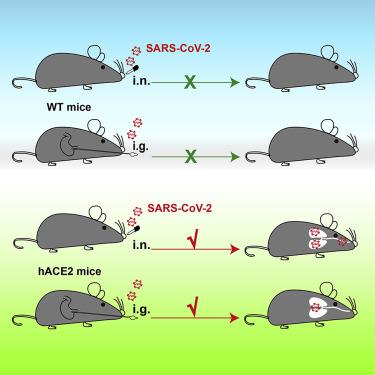Cell Host & Microbe ( IF 20.6 ) Pub Date : 2020-05-27 , DOI: 10.1016/j.chom.2020.05.020 Shi-Hui Sun 1 , Qi Chen 1 , Hong-Jing Gu 1 , Guan Yang 2 , Yan-Xiao Wang 2 , Xing-Yao Huang 1 , Su-Su Liu 3 , Na-Na Zhang 1 , Xiao-Feng Li 1 , Rui Xiong 3 , Yan Guo 1 , Yong-Qiang Deng 1 , Wei-Jin Huang 4 , Quan Liu 3 , Quan-Ming Liu 3 , Yue-Lei Shen 5 , Yong Zhou 6 , Xiao Yang 2 , Tong-Yan Zhao 1 , Chang-Fa Fan 7 , Yu-Sen Zhou 1 , Cheng-Feng Qin 1 , You-Chun Wang 4

|
Since December 2019, a novel coronavirus SARS-CoV-2 has emerged and rapidly spread throughout the world, resulting in a global public health emergency. The lack of vaccine and antivirals has brought an urgent need for an animal model. Human angiotensin-converting enzyme II (ACE2) has been identified as a functional receptor for SARS-CoV-2. In this study, we generated a mouse model expressing human ACE2 (hACE2) by using CRISPR/Cas9 knockin technology. In comparison with wild-type C57BL/6 mice, both young and aged hACE2 mice sustained high viral loads in lung, trachea, and brain upon intranasal infection. Although fatalities were not observed, interstitial pneumonia and elevated cytokines were seen in SARS-CoV-2 infected-aged hACE2 mice. Interestingly, intragastric inoculation of SARS-CoV-2 was seen to cause productive infection and lead to pulmonary pathological changes in hACE2 mice. Overall, this animal model described here provides a useful tool for studying SARS-CoV-2 transmission and pathogenesis and evaluating COVID-19 vaccines and therapeutics.
中文翻译:

SARS-CoV-2感染和发病机制的小鼠模型。
自2019年12月以来,新型冠状病毒SARS-CoV-2出现并迅速传播到世界各地,导致全球公共卫生突发事件。缺乏疫苗和抗病毒药已迫切需要动物模型。人血管紧张素转换酶II(ACE2)已被确定为SARS-CoV-2的功能受体。在这项研究中,我们通过使用CRISPR / Cas9敲入技术生成了表达人ACE2(hACE2)的小鼠模型。与野生型C57BL / 6小鼠相比,年轻和年老的hACE2小鼠在鼻内感染后均在肺,气管和大脑中维持较高的病毒载量。尽管未观察到死亡,但在SARS-CoV-2感染的hACE2小鼠中发现了间质性肺炎和细胞因子升高。有趣的是 在hACE2小鼠中,SARS-CoV-2的胃内接种可引起生产性感染并导致肺部病理变化。总的来说,这里描述的这种动物模型为研究SARS-CoV-2的传播和发病机理以及评估COVID-19疫苗和治疗剂提供了有用的工具。











































 京公网安备 11010802027423号
京公网安备 11010802027423号